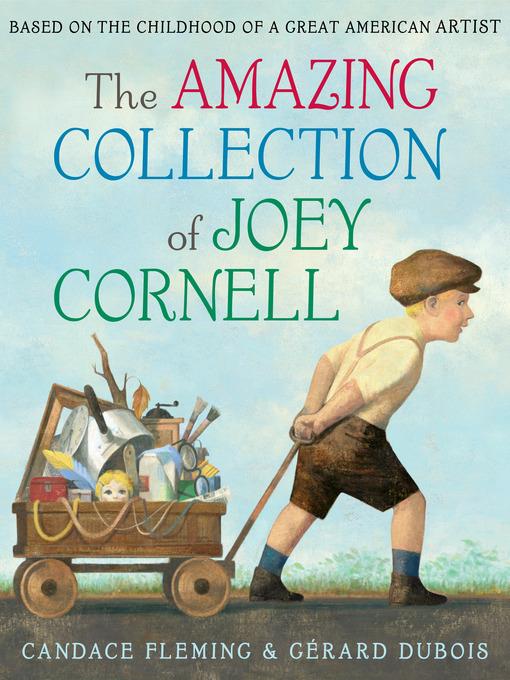
The Amazing Collection of Joey Cornell
Based on the Childhood of a Great American Artist
فرمت کتاب
ebook
تاریخ انتشار
2018
Lexile Score
560
Reading Level
0-2
ATOS
3.1
Interest Level
K-3(LG)
نویسنده
Gérard Duboisشابک
9780399552403
کتاب های مرتبط
- اطلاعات
- نقد و بررسی
- دیدگاه کاربران
نقد و بررسی

January 15, 2018
In this fictionalized account, Fleming focuses on the childhood of outsider artist Joseph Cornell, when he began collecting the found objects that would later comprise his assemblage pieces. She explains that Cornell initially kept his collections in a wheeled wagon in his bedroom, before eventually expanding into the barn. His sisters call him a “trash picker” and “pack rat,” but his mother dubs his collecting habits, “Weird... but wonderful.” Throughout, Fleming alludes to Cornell’s inspirations and influences, including a performance by Harry Houdini (after seeing Houdini’s show, Cornell adds an iron safe to his collection). The death of his father led him to immerse himself in his collection; in organizing the pieces, he determines he isn’t just a collector but an artist. In DuBois’s enigmatic art, Cornell, his mother, and his siblings resemble artifacts themselves, looking a bit like antique bisque dolls. Fleming sensitively conveys how an artist’s work is an evolving collage of experiences and observations that, together, creates meaning. An introductory note dives into Cornell’s later life. Ages 4–8. Author’s agent: Ethan Ellenberg, Ethan Ellenberg Agency.

January 1, 2018
Gr 2-5-A brief glimpse into the early life and first artistic stirrings of a great American artist. In the Author's Note, Fleming explains that Joseph Cornell, known for his found art and collage shadow boxes, began collecting objects and ephemera as a young child-and never stopped. For Cornell, the emotional resonance and meaning behind his arrangement of odd and ends was most apparent to children, who could more easily tap into their imaginative powers. Indeed, Fleming includes this quote from the artist in her note: "The question is not what you look at, but what you see." The book, however, does not spend much time looking at his boxes or concerning itself with Cornell's artistic career as an adult, focusing instead on his childhood collecting and the lead up to his first art show: in his family's barn in Nyack, NY, as a young teen. Dubois's acrylic artwork, with its layers of paint and woodlike textures, somewhat recalls the weathered paint style seen in many of Cornell's boxes, and there is loving attention paid to the detailed depiction of Cornell's tiny treasures, but his figures often have a mannequin-like flatness. Fleming's language alternates between the straightforward and the lyrical ("That same year, his father brought home two tickets to see... HARRY HOUDINI!/Tied with chains./Locked in an iron box./Joey sat spellbound."). This will likely resonate with young collectors and aspiring artists, though Jeanette Winter's Mr. Cornell's Dream Boxes does a better job explaining and exploring Cornell's unique style and connection to young people. VERDICT An attractive but brief, and thereby somewhat unsatisfying, depiction of Cornell's early life. Interested young artists will want to supplement this with further reading or internet searches for images of Cornell's work.-Kiera Parrott, School Library Journal
Copyright 2018 School Library Journal, LLC Used with permission.

December 1, 2017
A boy amasses a collection of assorted objects and uses them to make art.As a child, Joey has keen, eclectic preferences for his collection of items. A cork ball, a soap-bubble pipe, a rusty iron safe, a feather that falls fresh off a bird--Joey saves everything "that spark[s] his imagination or delight[s] his eye." Asked what his plans for his oddments are, he's unbothered: "Who knows?" After a while, he knows: "sifting, layering, mixing" the objects creates sculpture. His family finds his pieces "heavenly" and "magical"--and so do many other people after Joey grows up to become a professional artist using the same media, though the adult career and work of Joseph Cornell are oddly unmentioned except in the author's note. Fleming does a bang-up job explaining Joey's imaginative combination of objects to evoke emotion. DuBois' acrylic illustrations are a mixed bag: magnificent composition, and the value extremes on a few spreads are dramatically gorgeous; however, figures are stiff, more like frozen white mannequins than humans--Joey often looks like a doll--and Joey's sculptures appear quaint but murky and nondeliberate (the opposite of Cornell's real pieces). Three reproductions of Cornell's work are fruitlessly tiny. Alison Baverstock's Joseph Cornell: Secrets in Box (2003), now sadly out-of-print, is the superior treatment.Conceptually intriguing but insufficiently visually connected to Cornell's aesthetic. (bibliography) (Picture book/biography. 5-8)
COPYRIGHT(2017) Kirkus Reviews, ALL RIGHTS RESERVED.

November 1, 2017
Grades K-3 Joseph Cornell's iconic boxes now reside in museums the world over, but where did the self-taught artist get his start? Fleming and Dubois endeavor to answer that question in this account of the artist's childhood. Dubois' charmingly old-fashioned paintings depict young Joey picking up fascinating objects around his home and neighborhood, which he keeps in an ever-growing collection. He picks up feathers, doll parts, scraps of paper, and anything that sparked his imagination or delighted his eye, and when he's asked why he'd want such a thing, he always replies, Who knows? As Joey gets older, his collection takes up more and more room in Dubois' illustrations. Eventually, Joey starts to see connections among all the magical, fascinating, and exotic objects, and when his family struggles with grief, he creates something wholly new and lovely to bring them some joy, too. Fleming's emphasis on inspiration, even from the most ordinary places, should empower little ones to make art of their own. An opening author's note adds further details about Cornell and his art.(Reprinted with permission of Booklist, copyright 2017, American Library Association.)

























دیدگاه کاربران